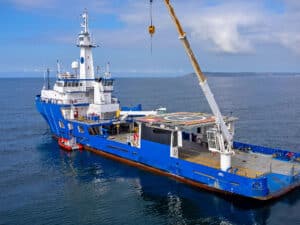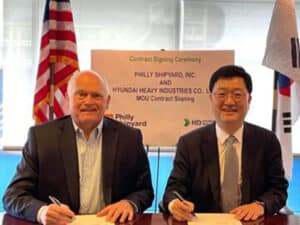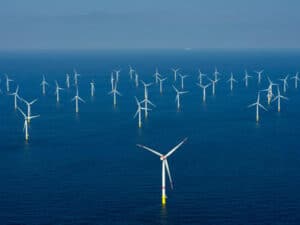
Celebrating a milestone: EBDG marks 25th anniversary
Written by Shirley Del MAY 17, 2013—Twenty-five years ago a group of employees from Nickum and Spaulding Associates (N&SA) decided to buy the company’s assets and launch what would become one of the most well known names in the marine engineering and naval architecture field—Elliott Bay Design Group. John Waterhouse, PE, Chief Concept Engineer, Elliott Bay Design Group, was part of that group of founding partners and understood the legacy and value behind N&SA.
MAY 17, 2013—Twenty-five years ago a group of employees from Nickum and Spaulding Associates (N&SA) decided to buy the company’s assets and launch what would become one of the most well known names in the marine engineering and naval architecture field—Elliott Bay Design Group. John Waterhouse, PE, Chief Concept Engineer, Elliott Bay Design Group, was part of that group of founding partners and understood the legacy and value behind N&SA.
Elliott Bay Design Group’s John Waterhouse, P.E., Chief Concept Engineer (standing), with Joe Pritting, President, and Brian King, Vice President, Engineering
That legacy began nearly 60 years prior when in 1931 W.C. Nickum and his sons Bill and George Nickum founded W.C Nickum and Sons. The firm would notably go on to design the Evergreen State Class for Washington State Ferries (WSF) in 1953—vessels which to this day remain in operation. The Evergreen State Class measures 310 ft x 73 ft x 15 ft and carries between 800 and 1,092 passengers.
Around that same time, Philip F. Spaulding established his own architecture firm, Phillip F. Spaulding and Associates, sparking fierce competition between the two entities over the next two decades—but in 1972 the firms merged to create Nickum and Spaulding Associates. Phillip Spaulding, as most in the industry know, was the brain behind WSF’s Jumbo Class design—the 440 ft, double-ended ferries continue to carry 2,000 passengers for the state operator today.
MAKING A NAME FOR ITSELF
While many aspects of Nickum & Spaulding transferred over to EBDG—the archive and accounting systems, project management tools, and five former N&SA staff members—EBDG founders decided early on to not continue under the N&SA name. They also decided not to name it after themselves, because as Waterhouse puts it, “it really wasn’t about us—but rather about establishing a new firm for the long haul.” Instead, the founders opted for a name they felt would encompass what the new group was about. “We felt that the combination of a marine place (Elliott Bay) with our passion (Design) and our collective approach (Group) made sense,” explains Waterhouse.
 Its mission from the start, says Waterhouse, has been to “provide a high level of service to its customers by creating a work environment of professionals that truly want to give their best.”
Its mission from the start, says Waterhouse, has been to “provide a high level of service to its customers by creating a work environment of professionals that truly want to give their best.”
With that goal in mind EBDG set out to employ a staff that could meet and surpass the company’s mission. The strategy was to employ staff members that had prior experience of working at a shipyard or operating a vessel. That approach, says Waterhouse, “has resulted in a focus on quality engineering products that demonstrate an understanding of construction, operations, and maintenance.”
The 128-passenger Mare Australis was designed for one-week excursions through the Straits of Magellan
That thorough understanding is one of the hallmarks of EBDG’s accomplished record. For instance, its ability to keep up with regulatory environments helps EBDG staff to better understand the regulatory process and its changes, and facilitates the information flow to its clients. This openness has enabled EBDG to work with NFPA on fireboat standards, ABS on small vessel rules, PVA on passenger vessel issues, and Inteferry on IMO regulations, says Waterhouse.
NAPKIN SKETCHES AND NOTABLE PROJECTS
From its start EBDG has been unafraid to push the envelope on the design front. When asked what five projects best exemplify EBDG’s innovative spirit, Waterhouse notes:
(1) The 54-Car ferry Christine Anderson—Designed for Pierce County, WA, for operation between Anderson, Steilacoom and Ketron Islands, the 214 ft, 150-passenger vessel (shown at right) established EBDG as a leader in ferry boat design. It was the firms first complete ferry design project. The scope of work included design, construction liaison and support services.
(2) The Ship Docking Module (SDM)—What started out as a napkin sketch evolved into a very unique ship assist tug. The SDM, designed on behalf of Hvide Marine and developed with Seabulk Towing, Inc., is a maneuverable, efficient and flexible 90 ft tug that produces 100% of its ABS-certified bollard pull of 120,000 lbs in any direction, says Seabulk. The SDM is part of the Seabulk fleet and operates in Port Everglades, Tampa Bay and Mobile Bay.
(3) The Mare Australis—The 230 m, 128-passenger cruise ship was designed for one-week excursion operations through the Straits of Magellan and around Tierra del Fuego between Chile and Argentina. This project, says Waterhouse, shows EBDG’s willingness to support clients from around the world. The contract required EBDG to design a vessel that would be similar to the already existing Terra Australis, have it comply with SOLAS requirements and provide excellent seakeeping characteristics in an easy-to-build hull form. Additionally, since the vessel would be built in Chile, EBDG had to provide both metric-size plate thickness and English-measure structural shapes and piping.
(4) AET Innovator—The firm designed what would become the world’s first purpose-built lightering support vessel (LSV) for petroleum tanker owner-operator AET. Waterhouse explains that the 185 ft vessel’s design was based on a unique hull form that would meet the need for constant freeboard at the stern, regardless of vessel loading conditions.
 (5) Well Stimulation Vessel for ONGC—Its work with well stimulation vessels garnered EBDG the attention of India’s Oil and Natural Gas Company. Recently the firm completed design work on a 350-ft, 38 megawatt well stimulation vessel for ONGC, shown at left. The project proved to be among the firm’s most challenging, but also provided EBDG the opportunity to learn and challenge its capabilities. According to Waterhouse, among the challenges was to design a vessel that would “meet strict dynamic positioning standards when operating in the Bay of Bengal during Monsoon season.” Additionally, there was the challenge to “understand and work with the incredible pressures required to inject liquids deep into the earth.” And of course, there is that 11 to 12 hour time difference between Seattle and India. But when discussing the project, Waterhouse says the firm has been very lucky because the project has helped EBDG better understand cultural nuances that come with working overseas. Joe Pritting, President, EBDG, echoes that sentiment saying, “This project has driven our growth and given us an opportunity to learn how to respond to a different culture.”
(5) Well Stimulation Vessel for ONGC—Its work with well stimulation vessels garnered EBDG the attention of India’s Oil and Natural Gas Company. Recently the firm completed design work on a 350-ft, 38 megawatt well stimulation vessel for ONGC, shown at left. The project proved to be among the firm’s most challenging, but also provided EBDG the opportunity to learn and challenge its capabilities. According to Waterhouse, among the challenges was to design a vessel that would “meet strict dynamic positioning standards when operating in the Bay of Bengal during Monsoon season.” Additionally, there was the challenge to “understand and work with the incredible pressures required to inject liquids deep into the earth.” And of course, there is that 11 to 12 hour time difference between Seattle and India. But when discussing the project, Waterhouse says the firm has been very lucky because the project has helped EBDG better understand cultural nuances that come with working overseas. Joe Pritting, President, EBDG, echoes that sentiment saying, “This project has driven our growth and given us an opportunity to learn how to respond to a different culture.”
FLEXIBILITY IS KEY
EBDG’s work history has taught the firm’s staff to be consistent in its determination to provide excellent service but also to be flexible.
Since 2006 the firm has worked with the Alaska Department of Transportation and Public Facilities (DOT &PF) on the highly anticipated Alaska Marine Highway System (AMHS) Alaska Class Ferry (ACF). The very public nature of the project and its broad group of stakeholders has made the project an ever-evolving one.
“It has been very interesting and exciting participating in the public process shaping the mission requirements for the Alaska Class Ferry,” says Brian King, PE, Vice President of Engineering. “Recently there has been a change in course for this project when it became apparent that a vessel designed to meet the stakeholder needs and still operate as a conventional Alaska ferry simply could not be built with the available funding.”
The new design includes a bow door, and integrates the changes to the terminals and operational changes, providing a faster roll-through loading and unloading process. “By focusing on fast turnarounds, the vessel can be smaller and does not need to be as fast,” says King. “The resulting design will be able to be built with the available funding and will cost much less to operate.”
In its “Alaska Class Ferry: Project Overview and Change in Direction” report, the Alaska DOT&PF states that “the department anticipates that both the design and construction times will be faster in comparison to the previous design concept”, and because of that it intends to build two Alaska Class Ferries within the appropriated budget.
REGAINING THE REIGNS AT EBDG
In 2006, EBDG opened up a Gulf Coast office to further develop relationships with new and existing clients in the region. A year later EBDG was acquired by transportation and services company American Commercial Lines (ACL). However, in 2011, “when private ownership purchased ACL,” says Pritting, the firm was “able to return EBDG to a small business with a broad ownership.” In what was an unprecedented yet unsurprising move, EBDG’s employees purchased the company from ACL—EBDG says it was “apparent that EBDG needed to be its own company once again—this time with a more inclusive business model. “This arrangement embraces the entrepreneurial spirit, drives our responsiveness and also aligns the interest of the company with the interest of the employees,” says Pritting. “We’ve enjoyed improved communication, high retention, and the benefit that comes from having engaged professionals doing what they love.” At the time of the buyout 23 of EBDG’s 39 employees, ranging from those at the top to the bottom, were part of the broad ownership. Since the buyout, the company has enjoyed zero turnover and has reopened the New Orleans office—which was closed for a short while in 2011. In fact the group is continually growing. At press time there were 52 EBDG employees in total, with additional hiring(s) actively taking place.
ALL ABOUT THE PEOPLE
Elliott Bay Design Group may be small in size but its staff’s wholehearted dedication to designing vessels that are “Better to Build, Better to Operate” is greater than ever.
It’s that spirit –of wanting to help its customers manage the mounting pressures on both economic and regulatory front through a good design—that drives the firm to its success.
“One of the things that 25 years has taught us is that people are what’s important. They do the work, keep clients happy and help create a productive atmosphere,” says Waterhouse. “We’ve worked hard to be the employer of choice by treating people with respect.”
“We wouldn’t be where were are today without each employee, past or present. When you sell professional services it truly is the people that make a business what it is,” says Christina Villiott, CPSM, Director of Marketing, EBDG. “At EBDG, we not only hire the best and brightest, but also the most dedicated. And each employee that has graced us with their passion and expertise has helped EBDG become the successful, employee-owned firm that it is today.”
For anyone looking to join the marine engineering and naval architecture field, and possibly have a career at EBDG, VP of Engineering, Brian King, has a few words of advice. “Don’t become a naval architect if you just like boats,” become one because the idea of creating tangible, functional, complex objects excites you. “There is a huge amount of job satisfaction that comes from standing on the deck plates of something you helped create…Observe and absorb every tidbit of knowledge that you can—there is value in it all. When given an opportunity, always take on the task that is outside your comfort zone—the task that you really think you don’t know how to do. If you do that, then you will become a great naval architect and have buckets of fun along the way.” And if you are that individual, “Come see us. We have a place for you on our team.”
An abbreviated version of this story was originally published in the May 2013 edition of Marine Log





Leave a Reply
You must be logged in to post a comment.